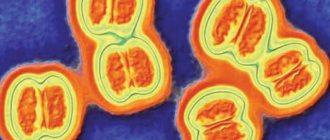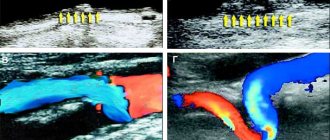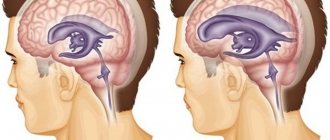Causes of headaches due to viral diseases, colds and flu
Headaches due to influenza and other viral diseases can occur for several reasons:
- intoxication, that is, poisoning of the body with toxins - waste products of viruses and bacteria;
- increased production of cerebrospinal fluid, which because of this puts pressure on the membranes of the brain;
- complications of colds: sinusitis - inflammation of the paranasal sinuses - or otitis - inflammation of the ear.
Diagnostics
The examination plan always includes a general blood and urine test. Based on their results, it is possible to determine the presence of an infection of viral and bacterial origin, as well as inflammation in the genitourinary system. A biochemical blood test, including determination of C-reactive protein and liver enzymes, is also indicative.
In some cases, an analysis for tumor markers is indicated. Only a doctor can determine the need for it based on complaints, anamnesis, examination and other studies. Independent assignment of this analysis is impossible due to the large number of indicators and its lack of information in some cases.
Headache as a symptom of a cold
Headaches due to colds are usually localized in the area of the eyeballs and forehead. It can be either unilateral or bilateral. The pain is moderate, but if complications develop, it can intensify, causing significant physical discomfort. If, during cephalalgia, mucous discharge from the nose becomes more abundant, this may indicate the spread of a viral infection to the nasopharynx. Headache, cough, runny nose, which do not improve with antiviral treatment, often indicate the occurrence of sinusitis. A dry or wet cough, sore throat and fever may also occur. These additional signs indicate a complex course of the cold and complications of respiratory viral diseases with laryngitis, sore throat or bronchitis - depending on the intensity of additional manifestations of the disease. A throbbing headache may indicate the development of a dangerous complication - meningitis, especially if the attacks are accompanied by vomiting. A headache with a cold without fever may indicate a weakening of the body’s defenses or a high risk of latent infectious diseases.
Reduced body temperature
Like high temperatures, low temperatures also indicate problems. Especially if it lasts for a long time. This leads to rapid fatigue, loss of mood, weakness of the body, etc.
Causes of low body temperature
A decrease in temperature is observed:
- with low hemoglobin;
- in case of internal bleeding;
- during pregnancy;
- if there are problems with blood vessels;
- for diabetes;
- with pathology of the adrenal glands;
- during brain tumors;
- with asthenic syndrome;
- during skin lesions;
- as a result of seasonal ARVI;
- in case of intoxication;
- as a consequence of hypothermia;
- with hypothermia.
Symptoms of low body temperature
Symptoms include:
- weakness;
- drowsiness;
- apathy;
- chills;
- feeling of cold.
Headache when coughing
A short-term headache when coughing occurs due to increased intracranial pressure during coughing. A typical attack does not last long – 20–30 seconds. It disappears when the cough ends. Similar painful attacks occur with cervical neuralgia and osteochondrosis. During coughing, turning the neck and tilting the head, the nerve endings are pinched, which leads to unpleasant sensations. Pain with cervical osteochondrosis always intensifies during coughing, since the act of coughing is accompanied by slight compression of the nerve structures located next to the cartilaginous tissues of the spine. In this case, the source of pain is often localized in the back of the head, accompanied by dizziness, a feeling of fullness and tinnitus. Osteochondrosis of the cervical spine occurs with impaired blood circulation in the brain and can cause dangerous complications. Therefore, do not delay visiting a specialist, especially if pain attacks occur regularly.
Examination methods
High-quality and timely diagnosis is the main condition for proper treatment. During the initial examination, temperature is measured and medical history is collected, including information about any chronic diseases. However, to understand the full picture, a number of additional examinations are necessary to make a final diagnosis. The doctor may prescribe the following methods:
- MRI of the head is a comprehensive, informative way to determine tumors, areas of ischemia and other pathologies of the brain;
- CT is a modern method of examination, which also allows you to obtain a complete three-dimensional picture of the brain;
- Dopplerography of the vessels of the head and neck is an important diagnostic stage, thanks to which cerebral circulatory disorders are detected;
- blood tests - tests will indicate inflammatory processes, the presence of infection, poisoning and other pathologies.
The Clinical Brain Institute has modern equipment for diagnosing diseases that are accompanied by headaches. This allows you to accurately and quickly determine the cause of deterioration in health and differentiate pathologies that are similar in clinical picture. It is impossible to make an accurate diagnosis at home, as well as as a result of a simple examination of the patient.
How to get rid of headaches
In order for headaches, runny nose, cough, and symptoms of respiratory viral diseases to subside as soon as possible, you need to take care of yourself by following a gentle regimen throughout the entire treatment period. Do not prescribe medications for yourself without first consulting a doctor - only a doctor knows how to relieve headaches during a cold and what medications should be prescribed in a particular case.
Non-drug treatment
- Minimize physical activity, ideally staying in bed and getting plenty of sleep.
- Refrain from books, TV, computer, smartphone - and in general from mental stress of any kind.
- Make sure the room has enough fresh air and is not too dry, hot or cold.
- Drink plenty of fluids. Water and other non-alcoholic drinks - berry fruit drinks, herbal teas, rosehip decoction - help remove toxins from the body, thereby eliminating one of the main causes of the development of symptoms of headache, cough and runny nose.
Drug treatment
Antipyretic drugs prescribed for the flu, as a rule, can relieve headaches, runny nose and weakness, but they should only be used when the body temperature is really high (from 38 ° C for children and from 38.5 ° C for adults). You should also use analgesics with caution: swallowing one painkiller tablet after another is unacceptable. In many cases, when treating headaches due to colds, you can give preference to herbal remedies. Dr. MOM® Phyto ointment, intended for both adults and children over 3 years of age, can bring noticeable relief to the patient. This is a local remedy used for headaches, colds, and viral infections. It contains four essential oils and helps relieve headaches from colds without fever or with signs of fever. When applied, the drug has a local irritating, distracting, anti-inflammatory and antiseptic effect. To get rid of headaches due to colds, Doctor MOM® Phyto ointment should be applied to the temples. When you are also worried about a runny nose, the ointment will also help ease your breathing if you apply it to the wings of your nose.
Increased body temperature
One of the serious signs of pathology in the body is an increase in body temperature. If numbers between 36.5 - 36.9 C are considered normal, then its rise is a signal from the body that an infection or virus has entered it and inflammation has begun. Doctors recommend treating this symptom as:
- the ability of your immune system to begin fighting various irritants;
- about the onset of various disturbances in the normal functioning of internal organs, as well as body tissues.
It is for this reason that it is worth considering the various factors and causes of body temperature fluctuations.
Causes of elevated body temperature
If you have a fever, do not immediately panic and start swallowing pills or calling a doctor. It is worth knowing that some causes of elevated temperature do not pose a danger to humans. Let's look at what you should pay attention to.
Non-dangerous causes include symptoms that will go away on their own:
- if the temperature rise occurs in the evening. Very often, it is at this time that it can rise 0.5-1 degrees above normal;
- as a result of emotional or physical stress. They will increase blood circulation, and with it heat exchange will increase;
- during ovulation in women. Often before the start of the menstrual cycle, hormonal surges are possible, and with this the body temperature rises;
- as a consequence of thermal loads. The presence of a body temperature of 37 and above can manifest itself as a result of eating hot food, visiting a bathhouse or sauna, taking a bath, or after sunbathing.
And now it’s worth talking about the pathological causes that can cause dangerous diseases:
- development of acute or chronic infections;
- various viral diseases, including influenza or ARVI;
- all cases of inflammation or swelling;
- for diseases of the respiratory system;
- if there are disorders of the thyroid gland;
- in case of injury to joints and muscles;
- during the course of a sexually transmitted disease.
Symptoms of elevated body temperature
It is worth saying that a significant increase in temperature will be felt by the person himself. The main symptoms include:
- feeling tired and weak;
- chills appear. Moreover, the greater the heat, the stronger the chill will be;
- the appearance of headache;
- the appearance of body aches. The joints, muscles and fingers are most often affected;
- the person begins to feel cold;
- burning and dry eyes appear;
- the mouth feels dry;
- Appetite may decrease or disappear altogether;
- increased heart rate, arrhythmia may appear;
- sweating increases or, conversely, dry skin.
How and when to bring down a high fever in an adult
Body temperature above 38.5C should be of particular concern. And yet, doctors recommend starting to bring down the temperature with medications when it reaches 38C.
But you should focus, first of all, on your general well-being. If the high temperature is poorly tolerated, unbearable aches, chills, confusion, physical discomfort, vomiting, dizziness are felt, then the temperature should be brought down immediately.
But it also happens that even a high temperature occurs with barely noticeable discomfort, then you should focus on the thermometer mark and, if it exceeds 38.5, take an antipyretic drug.
During fever and throughout the entire period of illness, it is important to drink as much fluid as possible. Through the excretory system, it promotes the rapid elimination of bacteria and viruses and their metabolic products - toxins. As a result, you will recover faster from a high temperature.
If there is a need to bring down the temperature, it is worth adding antipyretic drugs. It is better to give preference to single-component products. Adults are recommended to take paracetamol or ibuprofen based products. The use of multicomponent drugs, where paracetamol or ibuprofen are only part of the composition, should be used in extreme cases. And even more so, exclude the joint use of both.
When urgent medical attention is required
A severe headache with a cold can be a symptom not only of ARVI or uncomplicated influenza, but also of more dangerous diseases, such as meningitis. If the discomfort does not go away for a long time, increases with tilting the head and sudden movements, or is accompanied by nausea and vomiting, you should immediately consult a doctor.
There are other types of pain that may indicate the development of serious diseases. You should not delay visiting a specialist, especially in the following cases:
- a painful attack due to a cold or viral disease becomes intense and unbearable;
- painful sensations are combined with a pre-fainting or fainting state, muscle weakness;
- body temperature rises above 38 ° C, muscle spasms occur, which are localized mainly in the neck, photophobia develops - these symptoms may indicate the development of meningitis.
Treatment Options
Treatment tactics depend on the cause of the condition. Possible treatment options:
- antidepressants for anxiety disorders;
- antiviral for herpes infection (Vamciclovir, Famciclovir, Acyclovir, etc.);
- drinking plenty of fluids, bed rest and frequent ventilation during acute respiratory infections and acute respiratory viral infections;
- anti-inflammatory drugs for long-term chronic diseases;
- inactivators of toxic substances and symptomatic therapy for chronic poisoning.
The success of therapy depends not only on the doctor, but also on the patient. If a person is not ready for treatment and ignores the recommendations of a specialist, the chances of recovery are minimal. But with the right tactics and compliance with the instructions, relief occurs within a few days.
Read also: How to treat headaches due to a cold?
Dear patients! Remember that only a qualified doctor can make an accurate diagnosis, determine the causes and nature of the disease, and prescribe effective treatment. You can make an appointment with our specialists or call a doctor at home by calling 8-(4822)-33-00-33
Be healthy and happy!











